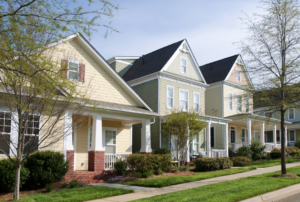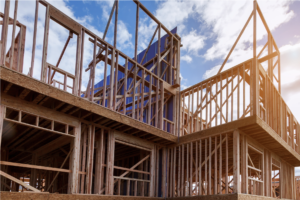Progress Made on Housing in 2024 Legislative Session
The 2024 Vermont legislature completed business on Saturday, May 11.
VAR appreciates the work of the legislature and looks forward to participating in several summer studies that were enacted this year. Following is a wrap-up of some of the issues that VAR worked on this year.
Click the tabs on the left below for details. (Updated July 29, 2024)
 Questions?
Questions?
Contact: Peter Tucker
Advocacy & Public Policy Director
peter@vermontrealtors.com
(802) 229-0513
 This 171-page bill enacts a number of changes to the Natural Resources Board and Act 250 permitting. This bill touches on a variety of topics that are important to Realtors®.
This 171-page bill enacts a number of changes to the Natural Resources Board and Act 250 permitting. This bill touches on a variety of topics that are important to Realtors®.
This Act changes the name of the Natural Resources Board to the Land Use Review Board (LURB), a five-person, full-time professional board. LURB will manage Act 250 permitting, providing guidance to the nine regional Act 250 commissions. The act authorizes LURB to review regional plans and maps and approve areas for Tier 1A status under the new Act 250 Tier system.
Originally, the bill proposed moving appeals of Act 250 permits to this new board. However, the final version establishes an appeals study committee. This committee will report back to the legislature on whether appeals should be heard by the Board or continue with the Environmental Court. The Vermont Association of Realtors® have been appointed to serve on this study committee.
Based on recommendations from the Natural Resources Board summer study that VAR participated in, this bill creates three Tiers for Act 250 oversight and review. The bill charges the LURB to approve rules and for the Vermont Association of Planners and Development Agencies (VAPDA) to map cities and villages to include expanded areas for residential development. Tier 1A includes cities that are currently described as Downtowns, mostly with water and sewer services. Tier 1B includes village centers. For any development in Tier 1A or 1B, the permitting requirements for the development plan are met if there is access to public water or sewer, or if the soil is adequate to support wastewater distribution.
VAR’s advocacy work focused on interim exemptions to Act 250 review for Tier 1A and Tier 1B Through July 1, 2027.
- In Tier 1A area, priority housing projects that provide 20% of housing at continually affordable rates will not be subject to Act 250 review. This exemption also applies to all residential projects with less than 75 units.
- In Tier 1B villages and within a ¼ mile radius of village centers, projects of less than 50 units will not be subject to Act 250 review. The expiration of these exemptions is scheduled to coincide with the acceptance of rules and mapping of Tier 1A and 1B areas.
The Act also revises the definitions of Forest Blocks and Connective Habitat and establishes new rules for these areas. A permit will not be issued for development in a Forest Block or Connective Habitat unless it is determined that the development will not cause undue adverse impact. If the development presents an undue adverse impact, a permit will only be issued if the project has a plan that will avoid, minimize, or mitigate the impact. The act also lowers the amount of required mitigation for primary agricultural soils for wood products manufacturers to 1:1 and amends the definition of accessory on-farm business and creates an Act 250 exemption for those businesses.
The LURB, in conjunction with the Agency of Natural Resources, is also charged with creating rules and maps to define Tier 3 areas described as critical natural resources areas. These critical natural resource areas are divided into two categories: forest blocks and connective habitats. Additionally, river corridors and headwaters are also considered critical natural resource areas. The impact of river corridors on most cities and villages, along with the need for flood resiliency, will necessitate identifying corresponding areas for residential development outside of our traditional villages and downtowns.
The act creates a new Act 250 jurisdictional trigger for the construction of roads, commonly known as the road rule. Any driveway for a single-family home exceeding 800 ft or any combination of roads and driveways for a subdivision exceeding a total of 2000 feet will be subject to Act 250 review.
This act renames the Municipal and Regional Planning Fund to the Municipal and Regional Planning and Resilience Fund. The act allows grants from the Fund to be spent on resilience planning, including flood protection and climate resilience. This act updates the State Designated Areas Program by renaming it to the Vermont Community Investment Program, updating the requirements for designation of an area, changing some of the incentives associated with the designations, and changing the authority for designating areas to the Land Use Review Board. It changes the title of the State Downtown Development Board to the Vermont Community Investment Board and changes its duties. This act increases the code improvement tax credit from $50 thousand to $100 thousand and the flood mitigation tax credit from $75 thousand to $100 thousand under the Downtown and Village Center Tax Credit Program.
This act imposes a new property transfer tax rate of 3.4 percent on residential property that is used as a second home and increases the clean water surcharge from .2% to .22% for a total tax on second homes of 3.62%.
It also increases the threshold for the initial .5% transfer tax on residential housing from $100 thousand to $200 thousand and increases the threshold for waving the transfer tax for borrowers using VHFA, VHCB and Rural Development Loans from $110 thousand to $250 thousand. All property transfer tax changes take effect August 1, 2024. The act also creates an education property tax exemption to freeze property values of certain newly constructed and rehabilitated principal residences.
The act allocates funds for several changes to State housing programs, including $5 million for the Vermont Rental Housing Improvement Program. It provides $1 million for the first-generation homebuyer program and a $1 million administration fee to the Vermont Housing and Conservation Board. The act appropriates $400 thousand for rent stabilization, $1.025 million to Vermont Legal Aid for tenant representation pilot program and $2.5 million for rental arrears assistance fund. It also appropriates funds to the Land Access and Opportunity Board and the Manufactured Home Improvement and Repair Program.
This act requires the Department of Housing and Community Development to publish a housing accountability report on an annual basis through 2030. This act imposes additional rental data collection requirements through the landlord certificate for use in emergency management and statewide housing needs assessments and requires additional safety disclosures for short-term rentals.
This act imposes new flood risk disclosure requirements for both real estate and residential rental units, including mobile homes and mobile home parks. It grants the Vermont Housing and Conservation Board an assignable right of first refusal for privately owned age-restricted properties and requires owners of privately owned age-restricted properties to provide notice of rent increases.
The act tasks the Department of Housing and Community Development and the Vermont League of Cities and Towns with reporting on land banks. It tasks the State Treasurer’s office with developing a pilot program for positive rent payment credit reporting. It also creates a legislative study committee to study landlord-tenant laws and evictions processes. Multiple effective dates, beginning on June 17, 2024.
 VAR testified in the House Committee on Commerce and Economic Development and the Senate Committee on Economic Development, Housing and General Affairs in support of this bill. Our testimony focused on Lumber, Labor, Land, Legal (permitting) and Lending. We emphasized Legal (permitting) as a key area where the legislature can encourage housing development. This bill successfully creates an incentive to lower construction financing costs by allowing developers to use real estate deposits in the construction process.
VAR testified in the House Committee on Commerce and Economic Development and the Senate Committee on Economic Development, Housing and General Affairs in support of this bill. Our testimony focused on Lumber, Labor, Land, Legal (permitting) and Lending. We emphasized Legal (permitting) as a key area where the legislature can encourage housing development. This bill successfully creates an incentive to lower construction financing costs by allowing developers to use real estate deposits in the construction process.
Act 96 permits a developer, who must deliver a public offering statement, to use purchaser deposits for the actual building and construction costs of the project in which the unit is located. The developer is required to obtain and maintain a surety bond and supply a copy to the purchaser. The bond can be an individual bond to cover each deposit or a blanket bond to cover all deposits received by the developer.
Developers like Great Gulf, working on the Killington Village Project, typically receive conventional financing from banks covering 60% of a development. By allowing developers to access deposit funds, they can secure an additional 20% for their financing, leaving only 20% more needed to launch the project. This will enable developers to accelerate construction, significantly boosting the grand list.
When this bill was introduced, it proposed that towns could not initiate a tax sale unless the taxpayer was more than 2 years delinquent and owed over $15,000 in back taxes. It also included a provision for a 3-year right to redeem property after a tax sale and imposed several notice requirements on towns, potentially leading to undue litigation. VAR was invited to join a stakeholder group, which resulted in a more favorable outcome.
Throughout this process and from various testimonies, VAR learned several key points. While town clerks generally attempt to work with delinquent taxpayers, there were no specific requirements to provide assistance. We supported language requiring towns to offer repayment plans to delinquent taxpayers early on, before taxes and fees accumulated. We also felt that setting a dollar threshold for initiating a tax sale did not address properties equitably and recommended its elimination.
We also learned that towns are still responsible for education taxes even if the property owner is delinquent, meaning all town taxpayers bear the burden of these unpaid education taxes. Additionally, about 80% of properties involved in tax sales are redeemed by the delinquent taxpayer before the end of the redemption period.
The final version of this bill accomplished a real balance, giving delinquent taxpayers the opportunity to enter into a repayment plan, and providing a clear path for towns to initiate a tax sale and a right-to-redeem period. The bill establishes a one-year delinquency period before initiating a tax sale, with no monetary threshold. It mandates that towns offer a repayment plan and encourages offering this plan during the delinquency period. Additionally, it retains the current one-year redemption period after a tax sale and maintains an annual interest rate of 12% to attract investors to tax sale properties.
 VAR was invited to observe a summer study group in 2023 to address compliance and education on Residential and Commercial Building Energy Codes. The result of this summer study was the creation of S.253. This act creates a Building Energy Code Work Group that is charged with
VAR was invited to observe a summer study group in 2023 to address compliance and education on Residential and Commercial Building Energy Codes. The result of this summer study was the creation of S.253. This act creates a Building Energy Code Work Group that is charged with
- Recommending strategies and programs to increase awareness of and compliance with the RBES and CBES, including the use of appropriate certifications for contractors trained on the energy codes.
- Developing plans and recommendations for a potential transition to a comprehensive program for the RBES and CBES at the Divisions of Fire & Safety, including potential funding sources.
- Considering whether or not the State should adopt a statewide building code.
The Vermont Association of Realtors® has been asked to participate in this working group. This act also authorizes the Secretary of State through the contractor registry to require contractors to affirm that they understand and are in compliance with the Residential and Commercial Building Energy Codes.

